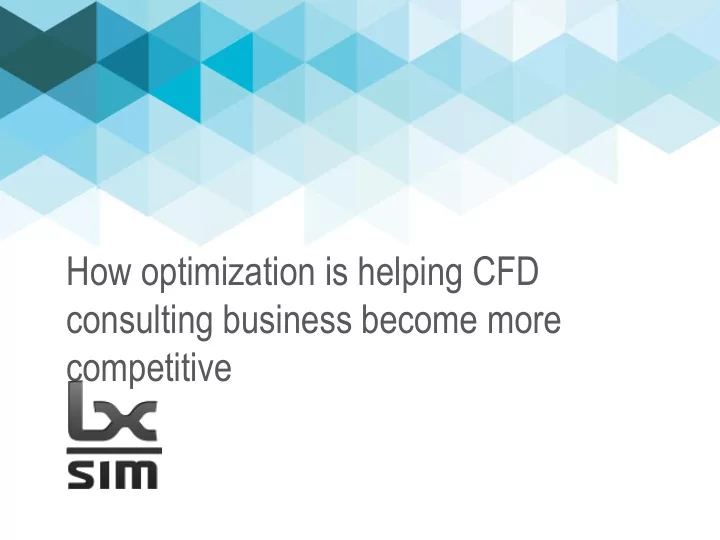

How optimization is helping CFD consulting business become more competitive
Annual investment in We have helped RS&DE to offer over 80 R&D cutting-edge solutions departments 10 qualified We master 10 high-end We delivered more than 250 employees softwares successful simulation and optimization projects
Optimization & Design exploration = • Instant expertise • Performance • Speed
Tools Optimat Hyperstudy e
Case 1 – HVAC, Wall-mounted faceplate
Case presentation • GOAL: Change the look • Original design: poor flow rate • MANDATE: GIVE DESIGN DIRECTIONS
Traditional approach Initial CFD Design New Propose Design alternative
Revised approach Initial Design Design Exploration Final Discussion Design
OPtimization Top spacing TOP length ROTATION ANGLE BOTTOM length Bottom spacing
sensitivity length Top spacing Rotation angle Bottom spacing
BENEFITS • Reduced time • Reduced cost • engineering integrated with design • Better performance
Case 2 – POOL equipment power optimization
Case presentation • GOAL: optimize power for reduced flow/rpm • Reduction of pump power per new regulations
Traditional approach • Fixed number of iteration • CFD with Best-guess initial design 1 • Analyze and design next iteration • Iterate (3 - 4 times due to cost) 2 • Prototype final design • Hope it works in all conditions 3
revised approach • DEFINE operation conditions • Choose design parameters 1 • Explore and optimize • Analyze and design next educated iteration • Simulate new design 2 • Iterate if necessary • Prototype final design 3
Optimization – initial model • Optimate+ • Use of 3d-Cad parameters • 50 simulations
OPtimization- parameters 3 parameters • Blade length • Blade curvature • Number of blades Objective • Maximize torque
Optimization - results
Optimization – final design
benefits • Faster turnaround • Reduced cost • Better understanding • Better performance
Case 3 – shape optimization of a bike parts
Case presentation • Goal: Increase aero performances • Fork • Downtube • design exploration and optimization
Traditional approach • initial design guess • CFD 1 • Analyze and design next iteration • Iterate (3 - 4 times due to cost) 2 • prototype 3 • Wind tunnel validation 4
revised approach • Evaluate primary shapes at different angles, speed … 1 • CFD with initial design GUESS 2 • Analyze and design next iteration 3 • Iterate (3 - 4 times due to cost) • prototype 4 • Wind tunnel validation 5
Example - downtube D1 4 parameters D2 2 constraints D3 Reduce drag at: • 0 deg • 15 deg • Combination D4
results - downtube D1 Results downtube • Circular constraint AT minimum D2 • Min thickness at trailing edge • 0 deg -35% • 15 deg - 71% D3 • Objective - 56% Results fork • Less restrictions • More complex conditions (wheel) • Objective - 35% D4
0 - deg before after
15 - deg before after
BENEFITS Better first approximation Faster global iterative process Evaluation of areas where reducing drag makes a difference Increased performances on parts where no wind tunnel data is available
Optimization & Design exploration = • Instant expertise • Performance • Speed
Recommend
More recommend